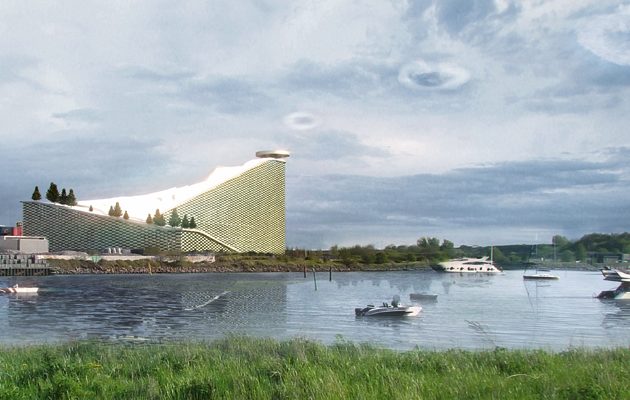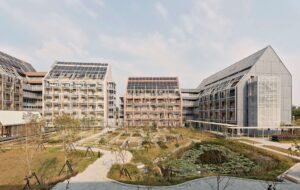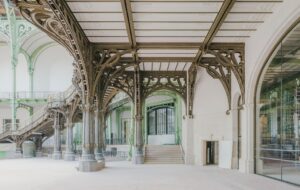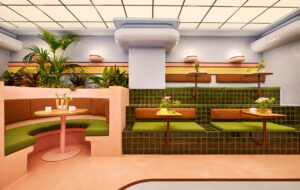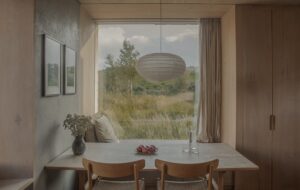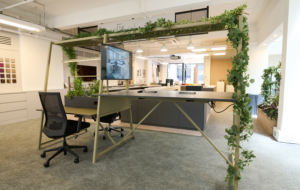|
(image: BIG and Glessner) |
||
|
Trailblazing Danish practice BIG is building a ski park on top of a waste-to-energy plant in Copenhagen – and the incinerator blows laser-lit smoke rings This article was first published in Icon’s November 2011 issue: Waste, under the headline “Green run”. Buy old issues or subscribe to the magazine for more like this Trailblazing Danish practice BIG is building a ski park on top of a waste-to-energy plant in Copenhagen – and the incinerator blows laser-lit smoke rings. It’s making an ugly but necessary building attractive without making it invisible. Do a Google image search for “waste-to-energy plants” and this is what you get: an uninspiring selection of boxy buildings sprawled over green landscapes, white fumes escaping from slender cigarette-like smokestacks and clunky cross-sectional diagrams that attempt to explain the workings of these industrial behemoths. Usually banished to the periphery of our cities, waste-to-energy plants – of which there are 431 in Europe and 89 in the US – do the dirty but essential job of incinerating our non-recyclable household rubbish and turning it into useful energy for electricity and heating. But, since January this year, a new image has joined the search results – a dreamy, almost utopian, set of renders by Bjarke Ingels’ practice BIG for its competition-winning proposal to build a waste-to-energy plant 3km outside Copenhagen. Planned to start on site in January 2012 and complete in 2016, the plant will encompass a 31,000sq m rooftop ski park and a chimney that puffs out one smoke ring for every 200kg of carbon dioxide emitted. It is an ambitious but brilliant proposal that is typical of BIG’s ability to tear up the rule book and radically change our perceptions of what a building should be and do. Energy company Amagerforbrænding picked BIG as the winner of the competition that started out as an unadventurous brief to build a new shell around the site’s existing plant. “The challenge of this competition was to make a big factory beautiful,” explains Ingels. “And we thought that rather than just wrap it in beautiful wrapping – we would turn the entire plant into a gift for the citizens of Copenhagen. What would have otherwise been a big factory that would block the view and cast shadows on the neighbours becomes a public park.” Denmark has the climate for skiing, but not the topography of its Scandinavian neighbours. The artificial ski park will comprise three trails for different abilities, as well as a mogul slope and a nursery slope. Snowflex, a system that uses moisture and traction to simulate real snow, will make the slopes usable all year round. Skiers will reach the top of the park using an internal elevator: a vertical promenade through the workings of the plant.
“The brief actually requested a visitor centre, a place to take the school kids to show them how waste turns into power,” Ingels says. “But you only go to a place like that once, and when your teacher tells you to. We wanted the plant to become a destination in itself. Normally the construction of a power plant downtown would be met with Nimbyism – in this case we are getting letters from people asking when they can expect to clip on their skis.” At 100m tall, the smokestack of the existing Amagerforbrænding waste-to-energy plant is comparable in height to the spires of Copenhagen City Hall and the Christiansborg parliament building. As a visible indicator of the plant’s newfound civic purpose, BIG’s design introduces a playful disc-shaped chimney mouth to the stack that fills up with smoke emitted by the incinerator and blows a ring over the skies of Copenhagen. Lit at night by heat-tracking lasers, the rings will serve as a constant reminder of the need to reduce waste. “The idea is to turn the chimney, the symbol of the factory, but also the symbol of pollution, into something playful,” says Ingels. “But more importantly, one of the main drivers of behavioural change is knowledge. If people don’t know they can’t act. When this plant has been realised, I’ll be able to tell my kids that once they’ve counted five smoke rings, we will have emitted one tonne of carbon dioxide.” For lead architect David Zahle, the project is not just about the ambitious rebranding of one plant to give it a new identity – it’s about taking the whole building typology out of the hands of industry and reclaiming it as a part of architecture. “Factories were high fashion in the industrial era,” he says. “But over the last 100 years, they’ve become more and more neglected. As environmental issues came back on to the agenda in the 1970s, big energy companies started caring again about how their buildings looked, so during the 1980s and 1990s a lot of factories were more like sculptures than buildings.” BIG isn’t the only high-profile architect that has been enticed recently to take on the huge blank canvas of a power plant. Thomas Heatherwick’s biomass power station in Teesside was given planning permission in March 2010. Like BIG’s plant, he attempts to integrate the height of the smokestack into one landform – lavish renders portray it as a gleaming volcano-like chimney, emerging from a mound covered in vegetation. Grimshaw, meanwhile, took a more straightforward tack in designing a waste-to-energy plant for Suffolk (approved in August this year): the main volume of his building is essentially an elegant and functional box that puts all the processes of plant on show and houses an energy education centre. Over the next ten years, many more of these designs will get the go-ahead, driven by legislative changes that encourage reduction in carbon emissions and pressure on landfill sites. It’s an exciting time for the typology, as it at last receives the attention of the architectural profession’s elite and the kind of funding that had previously been channelled into museums or galleries. Ingels says: “It’s a question of expanding the social potential of the urban infrastructure. The billion dollar investments that go into waste management, water treatment, power production, urban mobility … they don’t have to be restricted to be highway overpasses that scar the landscape and create wastelands beneath them. They could be designed in ways that are more symbiotic to the human activities around, above and beneath them.” The hopeful, romantic images of the Amagerforbrænding plant depict it as a multi-purpose model of industry, education, recreation, sustainability, civic importance and architectural beauty. However, romantic imagery is all we have to go on at the moment – for BIG, the hard work in making their bright idea come to fruition now begins. As the maverick among the set of pioneers exploring this new architectural territory, BIG’s adventurous attitude comes from a firm belief that great ideas can only come from pushing our existing knowledge to its limits. “Our buildings look different because they perform differently, respond to different conditions … and exploit different potentials,” says Ingels. “The new plant is an example of the idea that sustainability is not a burden, but can improve our quality of life.”
|
Words Riya Patel |
|
|
||

